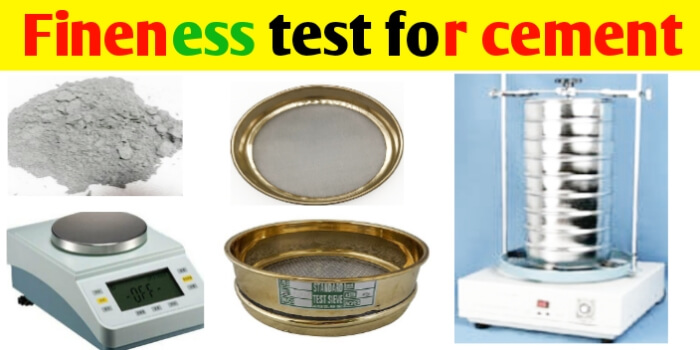The fineness of cement is commonly determined by the specific surface area, which is measured using the Blaine air permeability apparatus. The test involves passing air through a prepared bed of cement at a known rate and determining the pressure drop across the bed. The higher the specific surface area, the finer the cement particles. The result is usually reported in terms of square centimeters per gram (cm²/g).
Fineness test for cement, its Procedure & Apparatus, hi guys in this article you will know about fineness test for cement formula, Apparatus required, test procedure, Is code Sieve test and air permeability test for find out Fineness of cement.

The different particles of cement are not equal in size some are fine and some are course, particle size present in cement greatly affect its setting time, fine particle of cement hydrated and setting more quickly than course particle which take more time to hydrate and setting. so average size of particle present in cement should be not too fine and not too course.
How we decide the particle size in cement? It will be decided by fineness test for cement with the help of IS standard sieve size of 90µm,which define that residue of grain size more than 90 Micron of cement is not retained about more than10% on sieve,The standard cement should have fineness less than 10 % as per IS Recommendations.
As we know there is different types of cement available in market and their degree of Fineness is also vary but all the value of fineness for different cement is must be less than 10% percentage of residue by weight. For Example fineness value of ordinary Portland cement is 10%, rapid hardening cement is 5% and Portland pozzolana cement is 5%. So fineness of cement must be lies between 5% to 10%.
Fineness of cement describe about how much cement have fine and coarse particles,as above explanation rapid hardening cement and Portland pozzolana cement have more fine particle than ordinary Portland cement.
Fineness test for cement, its Test procedure, appartus,results & importance
Fineness of cement define as is property of cement that indicate particle size of cement and specific surface area,and indirectly effect heat of hydration. Fineness of cement is percentage weight of Residue is not retained more than 10% on Sieve (90 micron) test by sieve method.
Degree of fineness for cement is the measure of size of grain in it, there are three methods of testing of fineness of cement: 1) Sieve methods – using 90 micron sieve, 2) Air permeability methods – Nurse and Blaines method and 3) Sedimentation method – Wanger turbidimeter method. Sieve method measure grain size where as their permeability and sedimentation method measure surface area.
Demerits of Sieve test: Since cement grain are finer than 90micron, the sieve analysis method does not represent true means size of cement particles size and also tiny cement grains tend to conglomerate into lumps resulting in distortion in the final grain size. Due to this demerits, fineness is generally expressed in terms of specific area which is the total surface area of particles in Unit Weight of material.
Conditions affecting Fineness: chemical composition and the degree of calcination influence the hardness of the clinker and hence fineness to which the cement is ground, clinker with high iron content or silica or hard – burned is found to be hard and difficult to grind. Time of grinding and type of pulverizing machine also affecting the fineness of cement, it has observed that cement become finer with age provided that it does not absorb too much moisture. This is supposedly due to breaking of course Grand resulting from the hydration of embedded lime particles.
Importance of fineness of cement: there are following importance of fineness of cement: 1) it can decrease bleeding, increase in finance of cement increase the cohesiveness of concrete mix and thus reduce bleeding while compacting with vibrator, 2) It can increasing final setting time of cement,3) Fineness can also affecting workability,4) fineness test indirectly measure the surface area of particle of cement per unit mass,5) fineness increases the strength development in the cement principally during its first 7 days, 6) increase the rate of hydration, more is the fineness of cement particles more will be rate of hydration and 7) finer of cement leads to a stronger reaction with alkalies and increase the chance of shrinkage and cracking of cement paste.
there are three methods of testing of fineness of cement: 1) Sieve methods – using 90 micron sieve, 2) Air permeability methods – Nurse and Blaines method and 3) Sedimentation method – Wanger turbidimeter method.
Sieve method measure grain size where as their permeability and sedimentation method measure surface area. Sieve analysis method is easiest of 3, let us first discuss sieve analysis test for fineness of cement
Fineness test for cement by Sieve method:
The Fineness test of cement is done by sieving cement sample through standard IS sieve. The weight of cement whose particles size greater than 90 microns is determined and the percentage of residue retained cement particle on 90 micron sieve are calculated. This is known as Fineness of cement.
We know that cement hydrates when cement is mixed with the water and a thin layer are formed around the particle. This thin layer grows bigger and makes cement particles to separate. Because of this, the cement hydration process slows down. On other hands, cement smaller particle react much quicker than the larger particle. A cement particle with diameter 1µm will react entirely in 1 day, whereas the particle with diameter 10µm takes about 1 month.
But, there is a side effect of having too much of smaller particles in cement results in quick setting, leaving no time for mixing, handling and placing. Therefore to increase the setting time of cement, cement is must be manufactured in a different range of particle sizes.

Sieve test procedure for fineness of cement
AIM: To determine the fineness of cement by using 90 µm IS sieve as per IS: 4031 (Part 1) – 1996.
IS code for finance test of cement is IS: 4031 (Part 1) – 1996.
Appartus used for fineness test of cement is 90µm IS Sieve, Weight Balance having capacity 10mg to 100g, Nylon or pure bristle brush and sieve shaking machine (optional).

Sieve method test procedure:
● Collect a sample of cement and rub with your hands. The Fineness test sample should be free of lumps.
● Take 100 gm of cement sample and note its weight as W1.
● Drop 100 gm of cement in 90 µm sieve and close it with the lid.
● Now, shake the sieve with your hands by agitating the sieve in planetary and linear movements for 15 minutes in all direction or by Sieve shaking machine.
● After that take weight the retained residual cement which left on the 90 µm sieve as W2.
● Fineness test for cement formula is (W2/W1)×100
Fineness test for cement formula = (W2/W1)×100, where, W2 = Cement residue on sieve, W1 = Weight of given sample of cement.
Then after, calculate the percentage of Weight of cement-retained on Sieve.
Repeat this procedure with three different samples of cement and average the values for accurate results.
● Test Result 1 for sample: Let W1 = 100g, W2= 4.68, then fineness = (W2/W1)×100 = (4.68/100)×100 = 4.48%
● Test Result 2 for sample: Let W1 = 100g, W2= 6.28, then fineness = (W2/W1)×100 = (6.28/100)×100 = 6.28%
● Test Result 3 for sample: Let W1 = 100g, W2= 7.64, then fineness = (W2/W1)×100 = (7.64/100)×100 = 7.64%
Now average = (4.48%+6.28%+7.64%)/3= 6.14%, so Fineness value for given sample of cement is 6.14%.
The standard cement should have fineness less than 10 % as per IS Recommendations.
Air permeability test for fineness of cement:
Fineness of cement is determined by Nurse and Blaine’s method using an appartus developed by Lea and Nurse. Apparatus consists of permeability test cell, where cement is placed and air pressure is applied, flow – metre to determine the quantity of air passing per second through its capillary tube per unit. Difference of pressure and manometer to measure the air pressure.
Air permeability test procedure:
● A cement sample of 20 mm height is placed on perforated plate of 40 micron perforations and air pressure is applied and manometer connected to the top of the permeability cell and the air is turned on.
● lower end of the permeability cell is less then slowly connected to the other end of manometer.
● rate of flow is so adjust them that the flow metre shows pressure difference (h2) of 30- 50cm and reading (h1) in the manometre is recorded
● the process is repeated till the ratio h1/h2 is constant and specific surface is given by expression
S = 14/d(1_Ψ) (√AΨ^2/KL. √h1/h2)
Where, S = specific surface
L = thickness of cement layer
A= area of cement layer
d = density of cement
Ψ = porosity of cement (0.475)
h1 = manometer reading
h2 = Flowmeter reading
K = is the flow metre constant and it is obtained by Q = Kh2d1/μ
Where μ = viscosity of air
d1 = density
Q = quantity of air passed per second
Q = (V/t) × (P_p)/P
Where P = atmospheric pressure
p = vapour pressure of water at room temperature.
Minimum specific surface of cement are following:
● 2250 cm2/g for ordinary Portland cement
● 3250 cm2/g for Rapid hardening cement
● 3250 cm2/g for low heat cement
● 3000 cm2/g for Portland pozzolana cement
● 2250 cm2/g for high alumina cement
● 4000 cm2/g for super sulphate cement
Wagner Turbidimeter test for fineness of cement:
L. A. Wagner developed aur turbidimetre to measure surface area of 1 gram of cement, in this test cement is dispersed uniformly in rectangular glass tank filled with kerosene. Then parallel light rays are passed through the solution which is strike the sensitivity plate of photoelectric cell, turbidity of the solution at given instant is measured by taking reading of the current generated by the cell, recording the reading at regular intervals while the particles are falling in the solution it is possible to secure information regarding the grading in surface area and size of particles.
◆You Can Follow me on Facebook and Subscribe our Youtube Channel
You should also visit:-
1)what is concrete and its types and properties
2) concrete quantity calculation for staircase and its formula
This article helps them alot.Thank
you for sharing so well
This article are very useful for me.
Thank you somuch